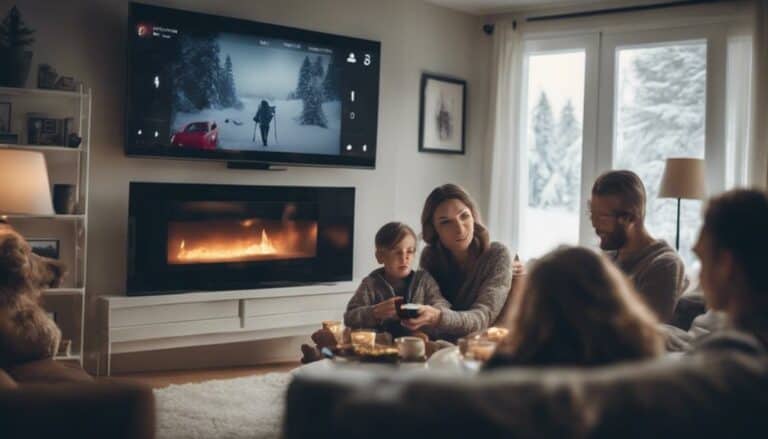In the age of smart homes, ensuring your nest is winter-ready with a smart thermostat setup isn't just about comfort—it's about efficiency and savings too.
You've likely heard the basics: adjusting your thermostat for day and night, and while you're away. But there's more to it than just setting and forgetting.
With the right tweaks, you can optimize your home's heating without breaking the bank. From understanding the ideal temperatures to mastering vacation mode, these 10 tips will equip you with the knowledge to keep your home cozy and your energy bills low.
Let's explore how you can take full control of your home's warmth this winter, without missing out on the potential benefits.
Key Takeaways
- Program your thermostat to 68°F during the day for optimal comfort and savings.
- Use vacation mode set to 55°F to reduce costs while away.
- Lower the temperature 10-15 degrees at night to save up to 15% on heating bills.
- Regular furnace maintenance and duct sealing enhance thermostat efficiency.
Optimize Daytime Temperatures
Setting your smart thermostat to 68°F during the day strikes the perfect balance between comfort and cost savings in winter. This temperature is the ideal balance, guaranteeing your home remains cozy without racking up high heating bills.
By maintaining this perfect daytime setting, you're not just enhancing your comfort but also promoting energy savings. A smart thermostat makes it easier to achieve this equilibrium. It allows for precise control and can adjust the temperature based on your daily schedule, ensuring efficiency.
Consistently keeping your thermostat at 68°F during daylight hours is a smart strategy for managing heating expenses effectively. This practice guarantees you enjoy a warm home environment while keeping an eye on energy consumption, offering both comfort and cost benefits.
Adjust for Nighttime Comfort
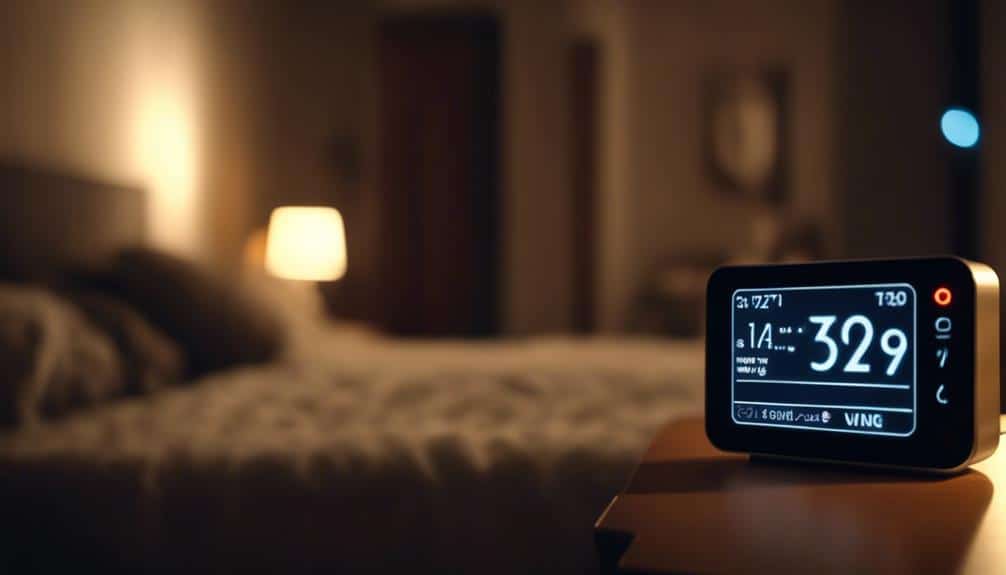
After optimizing daytime temperatures, it's equally important to adjust your smart thermostat for nighttime to save on energy costs while ensuring a comfortable sleep. The Department of Energy suggests a temperature reduction of 10 to 15 degrees for eight hours at night. This simple adjustment can trim your heating bills by up to 15% annually.
Not only does setting a lower nighttime temperature contribute to significant energy savings, but it also helps your home retain heat more efficiently. By programming your smart thermostat for an ideal nighttime temperature, you're ensuring both energy efficiency and a comfortable sleep environment.
Vacation Mode Settings

When you're planning to be away, activating vacation mode on your smart thermostat can help you save energy and money. Here's how you can make the most of this feature:
- Set a Minimum Temperature: Program your thermostat to maintain a minimum temperature of 55°F. This prevents frozen pipes without squandering energy.
- Guarantee Safety: Keeping your home at a stable temperature reduces the risk of heating system issues.
- Manage Heating Costs: Utilize vacation mode to reduce unnecessary heating costs effectively.
- Comfort Upon Return: Adjust settings to guarantee your home returns to a comfortable temperature by the time you're back.
Schedule for Efficiency
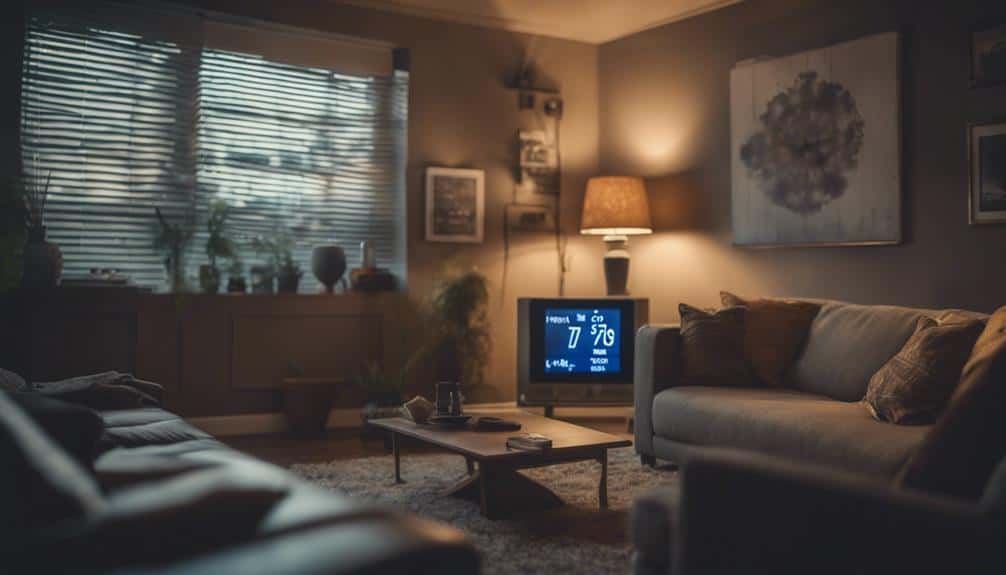
Optimizing your clever thermostat's schedule can greatly lower your energy bills and enhance your comfort during winter nights. By programming your thermostat to lower the temperature at night, you're not just saving energy; you're also creating a perfect sleep environment.
The Department of Energy suggests a 10 to 15-degree reduction in temperature for eight hours each night can lead to significant energy savings. This simple adjustment could slash your heating bills by up to 15% annually.
Setting your thermostat back at night is a tried and true method for achieving energy efficiency during the colder months. By maintaining consistent nighttime temperature adjustments, you're contributing to overall energy conservation and cost savings.
Embrace this schedule for efficiency this winter and enjoy the benefits.
Maintain Furnace Performance
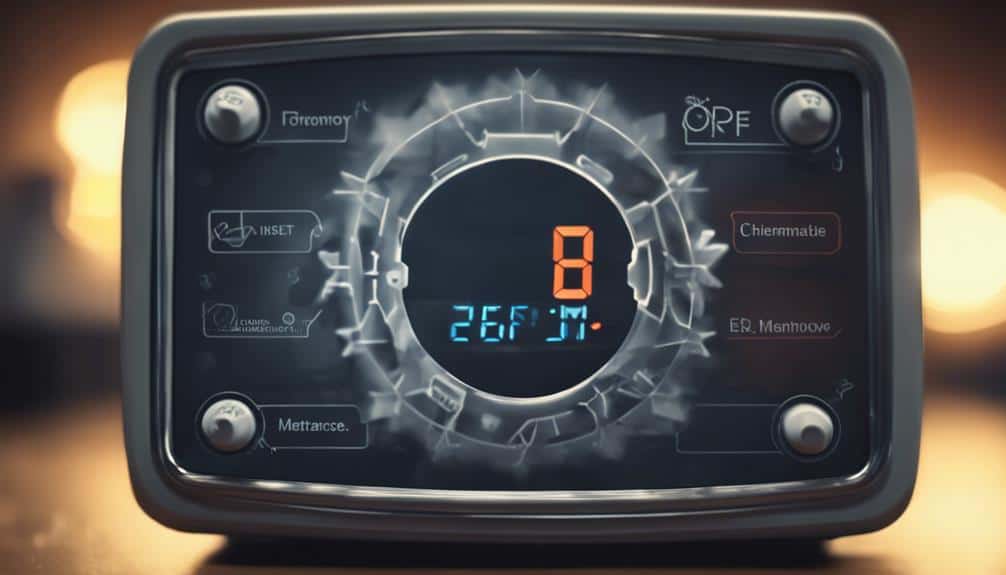
To make sure your heating system runs smoothly all winter, it's important to maintain your furnace's performance. Here are four key steps to optimize your system:
- Regularly change your furnace filter to enhance indoor air quality and make certain your furnace operates at peak efficiency.
- Schedule professional inspections to catch and address any issues early, preventing costly breakdowns.
- Seal any duct leaks in your HVAC system to improve efficiency and reduce unnecessary energy usage.
- Clean your air ducts as needed to prevent dust buildup and maintain proper airflow.
Lower Nighttime Heat
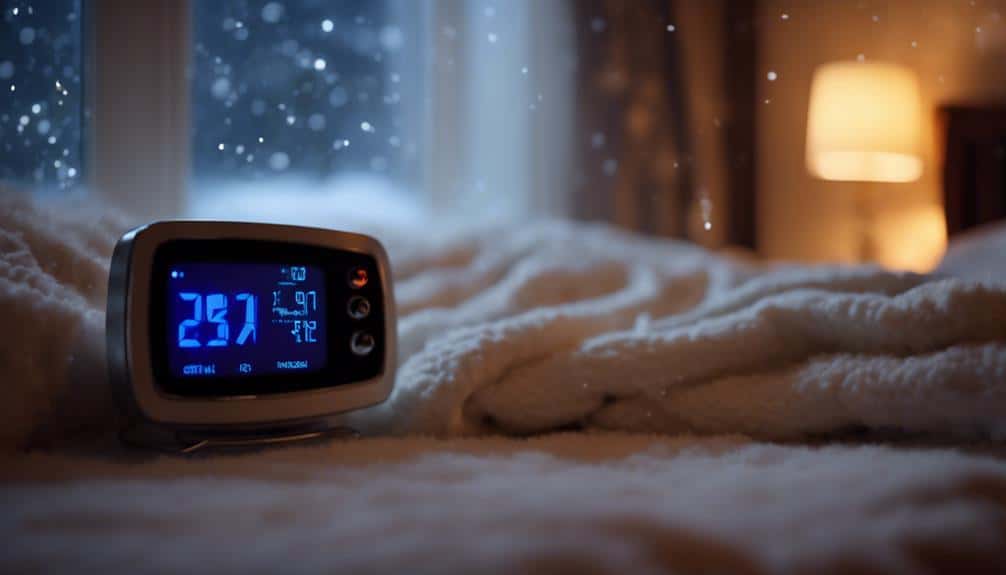
Turning down your thermostat at night isn't just a smart move for your wallet; it's also a healthier choice for your sleep. By setting your smart thermostat to the Department of Energy's suggested range, you're maximizing for both energy savings and a comfortable sleep.
Let's explore how lower nighttime temperatures can benefit you, the ideal settings to achieve this, and how it balances health and comfort.
Benefits of Lower Temperatures
Lowering your home's temperature at night can considerably reduce your heating bills, with the Department of Energy highlighting potential annual savings of up to 15%. By embracing lower nighttime temperatures, you're not just cutting costs; you're also stepping into a world of benefits that enhance both your home's efficiency and your sleep quality. Consider the following:
- Energy Savings: Slower heat loss during cooler nights means your system uses less energy.
- Lower Heating Costs: Adjusting your thermostat can greatly lower your monthly bills.
- Comfortable Sleep Environment: Cooler temperatures promote better sleep, improving your overall health.
- Improved Energy Efficiency: Optimizing your home's temperature settings leads to more efficient heating, saving money and the environment.
Embrace these changes for a cozier, cost-effective winter.
Optimal Nighttime Settings
Adjusting your thermostat down by 10 to 15 degrees at night could slash your annual heating bills by as much as 15%. This simple step isn't just about cost savings; it's about embracing energy-efficient practices that benefit both your wallet and the environment.
When you lower the nighttime temperature, your home loses heat more slowly. This slower heat loss is key to energy conservation. By setting a cooler temperature during these hours, you're optimizing your heating system's efficiency. It's a straightforward yet effective method to make sure you're not overspending on energy.
Embracing this habit nightly can lead to significant savings over time, proving that small changes in your routine can have a big impact on your heating energy usage.
Health and Comfort Balance
Setting your thermostat to between 58°F and 63°F at night can't only save you money but also promote more restful sleep. Adjusting the nighttime heat in your home to a lower temperature has several benefits:
- Energy Bills: A 10 to 15-degree drop can lead to up to 15% savings annually on heating costs.
- Comfortable Sleep: Cooler environments typically support better sleep quality.
- Efficiency: Homes cool down slower when the inside is already set to a lower temperature, maximizing energy efficiency.
- Savings: Besides trimming down energy bills, maintaining a comfortable temperature without overheating saves money without sacrificing comfort.
Embracing a cooler nighttime setting guarantees a balance between health, comfort, and savings, making it an essential practice for winter.
Manual Overrides Strategy
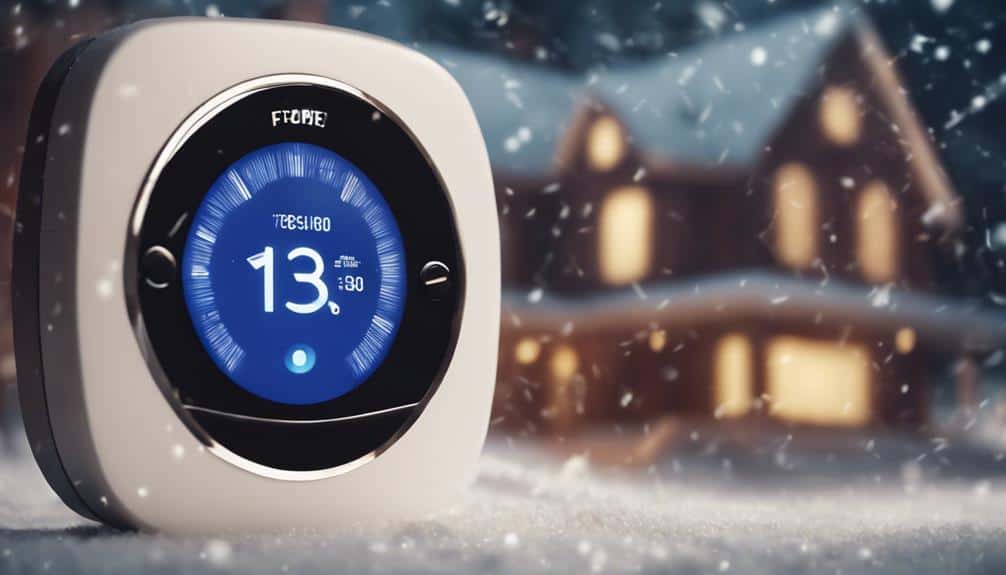
Harnessing the power of manual overrides on your smart thermostat offers immediate control over your home's temperature. This feature is a game-changer for reacting swiftly to unexpected weather shifts or personal comfort needs without messing with your overall settings.
Whether it's a sudden cold snap or an impromptu gathering that packs your living room, manual overrides give you the flexibility to tweak the temperature in moments. They're ideal for those times when your routine goes off-script, ensuring your space is always welcoming.
Zone Heating Approach
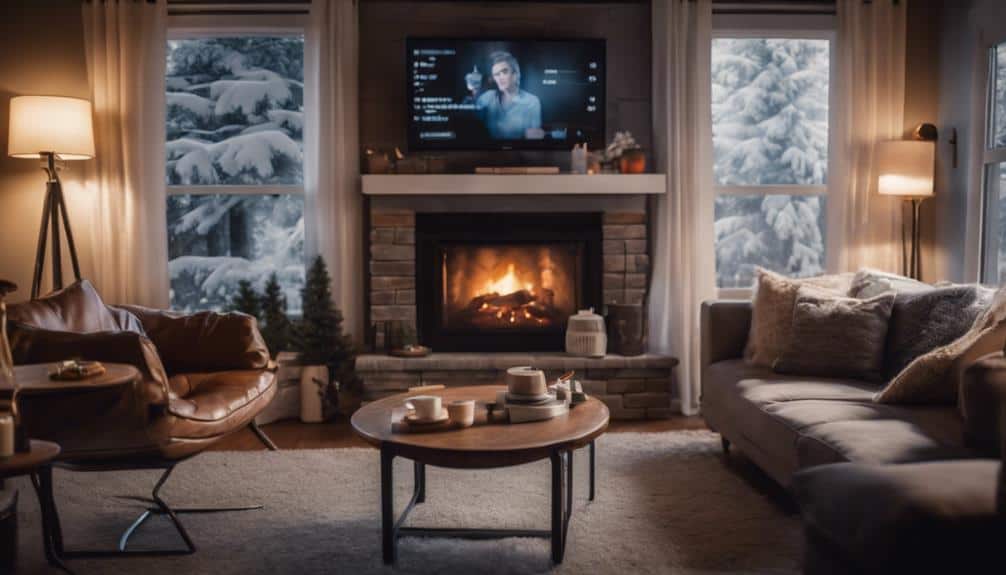
As you explore the zone heating approach, you'll first need to identify the best heating zones in your home.
We'll also guide you through installing zone control systems and managing temperature preferences efficiently.
This method guarantees you're only heating the spaces you use, cutting down on energy costs and enhancing comfort.
Identify Optimal Heating Zones
To identify best heating zones in your home, start by evaluating each room's usage and temperature requirements. Using a smart thermostat for each zone lets you customize temperature settings, optimizing energy usage and reducing energy consumption.
Here's how to approach it:
- Living Areas: High usage during the day; prioritize comfort.
- Bedrooms: Customize for night use; cooler during the day.
- Kitchen: Lower priority unless used frequently.
- Unused Rooms: Keep at minimal heating to save energy.
Zone Control Installation Tips
Having identified your home's best heating zones, the next step is installing zone control systems to manage temperature efficiently. Zone control installation splits your home into areas with independent thermostat settings.
By fitting dampers in the ductwork, each zone gets its own smart thermostat. This strategy allows heating only where and when needed, slashing energy waste. Your smart thermostat plays a pivotal role, adapting to specific usage patterns in each zone, thereby optimizing both energy savings and home comfort.
This approach not only tailors temperature control to different areas of your house but also leads to significant reductions in your energy bills. With zone heating, you're paving the way for a more efficient, comfortable home this winter.
Managing Temperature Preferences
By utilizing smart thermostats, you can effortlessly manage temperature preferences in different zones of your home, ensuring comfort while optimizing energy usage. Here's how:
- Implement zone heating with smart thermostats to control different areas individually, tailoring the climate to your needs and preferences.
- Customize thermostat settings for each zone based on usage patterns, ensuring rooms are heated only when needed, for maximum comfort and efficiency.
- Optimize energy usage by heating only necessary zones, greatly reducing heating costs without sacrificing comfort.
- Enhance heating efficiency and achieve savings of up to 30% on your energy bills, by creating personalized comfort zones that align with your lifestyle.
Smart thermostats and zone heating together offer a streamlined approach to managing your home's heating, ensuring both comfort and energy efficiency.
Managing Indoor Humidity
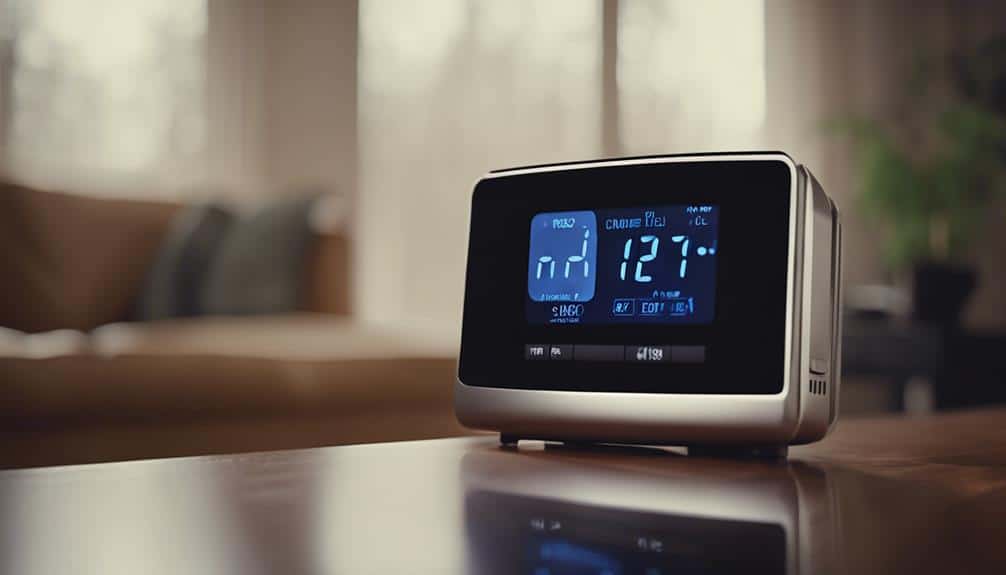
Maintaining indoor humidity within the 30-50% range is essential for your comfort and health during winter. Low humidity can cause dry skin, irritated respiratory passages, and annoying static electricity, making your home feel less comfortable.
On the flip side, high humidity leads to condensation on windows, mold growth, and a general feeling of discomfort. Luckily, smart thermostats are here to help. These intelligent devices can monitor and adjust your home's humidity levels, ensuring they stay within the recommended range.
Troubleshooting Thermostat Issues

While smart thermostats can greatly enhance your home's comfort by managing humidity, it's important to address any thermostat issues that might arise to maintain this level of comfort. Troubleshooting can often be simple and straightforward. Here's what you can do:
- Check for continuous running or short-cycling, common symptoms of thermostat issues.
- Simple steps such as changing batteries, checking the fuse box, and cleaning the air filter can resolve many problems.
- Resetting the thermostat by turning it off and on might fix minor glitches.
- Clean any dust or debris around the thermostat for best functionality.
For more complex problems or when considering smart thermostat upgrades, don't hesitate to seek professional maintenance assistance.
Frequently Asked Questions
What Should a Smart Thermostat Be Set at in the Winter?
You should set your smart thermostat to around 68°F in winter for energy savings and comfort balance. At night or when away, lower it to 65-62°F. Use vacation mode and zone control for extra efficiency.
How Do You Use a Smart Thermostat Efficiently?
To use a smart thermostat efficiently, focus on energy savings by adjusting for your usage patterns. Utilize zone control and remote access for convenience. Don't ignore maintenance reminders to guarantee peak performance and savings.
Is 75 Degrees Hot for a House in Winter?
Yes, 75 degrees is hot for a house in winter. It can decrease energy savings, affect comfort levels, and impact health due to low humidity. Seasonal adjustments can improve comfort and control humidity more effectively.
Is 72 Too High for Thermostat in Winter?
Yes, setting your thermostat to 72°F in winter might be too high. You'll find better energy savings and comfort balance at 68°F, using programmable settings to adjust for zone heating and temperature fluctuations.
Conclusion
In wrapping up, you've got the essentials to make your smart thermostat winter-ready. Remember to tweak those daytime and nighttime settings for comfort and savings, don't forget about vacation mode, and always keep efficiency in mind.
Regular maintenance of your furnace can't be overlooked, and knowing when to override your system manually can be a game-changer. Consider zone heating for targeted warmth, manage indoor humidity for extra comfort, and be ready to troubleshoot any issues that pop up.
Stay warm and save big this winter!

